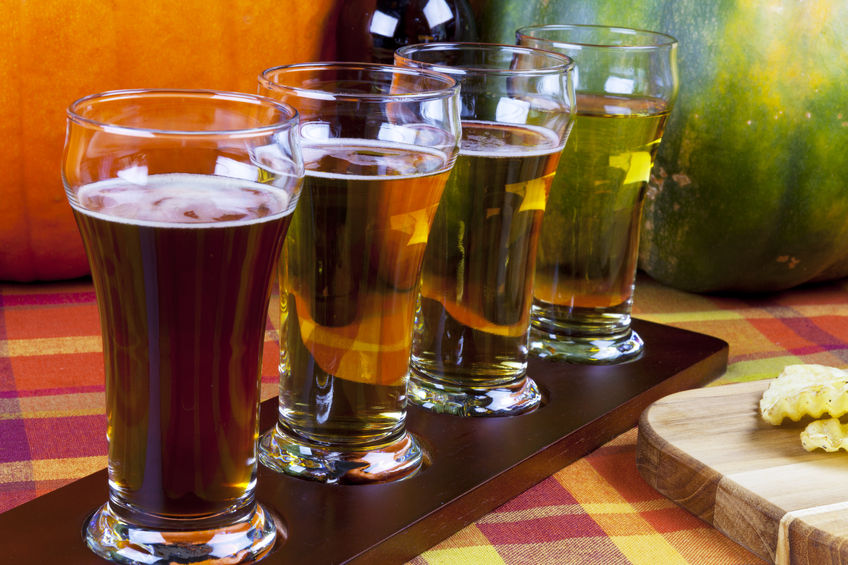The Hip Chick’s Guide to Beer
We are celebrating Octoberfest at SharpHeels with a spotlight on an October staple, beer. Look for our multi-part articles to encourage women to appreciate and enjoy beer.
If you associate beer bowling, bald men and bachelor parties, or you think that all beer tastes like the cheap swill found in red plastic cups at college parties, it’s time you learned about the brew-tiful awesomeness of beer. People have brewed beer for thousands of years, and although new ingredients and updated facilities are used today, the basic process has remained unchanged.
Although beer has long carried the sitcom stigma as a man’s drink—the fuel of bungling clows, sports-obsessed man-children, or large, lazy, beer-bellied bar-brawlers—times, they are a changing. Beer, once considered a fine beverage that women happily made and served to their families, is regaining its rightful place at table, and everyday breweries large and small offer more complex beers for the masses to savor.
Hip chicks drink beer. Women are enjoying more beer, more often than ever before. However, the large selection of beers intimidates some women, and they have little idea where to begin their beer education. Sometimes women order white wine out of habit when they could be awakening their tastebuds with a great lager. A basic knowledge of beer production and classification go a long way toward making beer more accessible and less intimidating.
Most beer falls into two main subgroups: ales and lagers. Four main ingredients: barley, hops, water and yeast; combine to create both ales and lagers. The ingredients pass through a five-step process to become beer. The grain, which is primarily barley but can include other grains such as rye, are heated dry and cracked in a process called malting that releases the enzymes in the grains needed to produce beer. The malt mixes with hot water next for sparging, or lautering, which extract the sugars through a steeping process. A sweet liquid called wort forms, from which the grains are removed, and is used as the basis for beer. Next, hops are added to the wort, and the mixture boils for about an hour. The bitterness of hops balances the sugary sweetness of the wort to create the perfect brew.
When the perfect brew is achieved, the wort is filtered before yeast is added to start the fermentation process. Fermentation joins the sugars from the grain with yeast to create alcohol and CO2. It is at this point in the process where the brew road diverges into either ale or lager. Ale is stored for a few weeks at room temperature before it is bottled. Lager lingers longer in the fermenation process, for months instead of weeks at a cold temperature slightly above freezing. When fermentation ends, the brewer adds carbonation, then, the beer is bottled and aged.
What does that brew-tiful beginning mean to you when you are staring at the beers on tap at a restaurant or pub? The variety of yeast used determines the divergent road to ale or lager, and consequently predicts the taste. This is not a perfectly hard and fast rule, because occasionally the roads intersect in interesting and tasty ways. Ales tend to be more aromatic and full of intense flavors than lagers. Although often lighter in color, ales can pack a bigger punch than lagers. This can mislead beginners and cause “beer face” to those not ready for the ale experience. (Some will have seen this face on a novice drinking the now-trendy IPA or India Pale Ale.) Lagers, on the other hand, tend toward a more mellow beer drinking experience. Their taste is often less heady than ale, making lagers a good choice for some beginning beer tasters.
Truthfully, although the division between ale and lager is a good beginning, it is only a beginning. As with the acquired tastes for any other food or beverage, what one person loves, another may find offensive. Sampling is truly the best way to discern what beers appeal to your palate. Sample a beer flight (a tasting of beers arranged by intensity of flavor) at your local pub or ask your server for recommendations at your favorite restaurant. Knowledgeable servers and bartenders will be able to ask you the right questions then offer recommendations to pair your tastes and your meal with the perfect beer.
You have worked hard to have every opportunity usually offered to the “boys.” You studied engineering or business. You fought your way to the C-suite. Don’t let the boys have all the fun. Hip, powerful, sharp women drink beer.
7 Effective Communication
Effective Communication Women Making History
Women Making History Grants & Funding Sources
Grants & Funding Sources Interview Prep
Interview Prep Impactful Leadership
Impactful Leadership Dressing for Work
Dressing for Work Dressing for Your Style
Dressing for Your Style Interview Style Tips
Interview Style Tips Women's Stocking Stuffers
Women's Stocking Stuffers Gift the Busy Traveler
Gift the Busy Traveler Airport Layover Activities
Airport Layover Activities Traveling & Eating Healthy
Traveling & Eating Healthy Travel Like a Boss Lady
Travel Like a Boss Lady The Dual California Life
The Dual California Life Gifts for Thanksgiving
Gifts for Thanksgiving Summer Reading List
Summer Reading List Top Leisurely Reads
Top Leisurely Reads New Year, New Books
New Year, New Books Life Lessons from a Sitcom
Life Lessons from a Sitcom Oprah, Amy or Amal?
Oprah, Amy or Amal?






